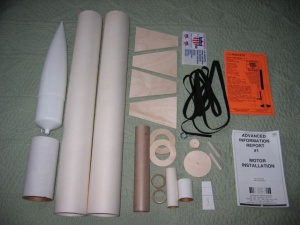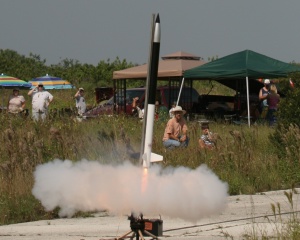| Construction Rating: | starstarstarstarstar_border |
| Flight Rating: | starstarstarstarstar_border |
| Overall Rating: | starstarstarstarstar_border |
| Manufacturer: | U.S. Rockets  |

Brief:
The U.S. Rockets (USR) Sonic 3100 is a lightweight, super high performance high
power rocket that can fly on most 29mm and 38mm motors. The builder must supply
their own parachute for recovery. While built predominantly stock, I also added
a few extra parts so that I can optionally recover using dual deployment
techniques. There is a 54mm MMT version of the Sonic 3100 available as well.
Construction:
The kit has the following parts:
- 2 BT-30-24 body tubes
- 1 TC-30-6 tube coupler
- 2 CR-30-16 centering rings
- 1 PP-30 coupler plate
- 1 BT-16-9 motor tube
- 38-29mm motor adapter, consisting of:
- 1 TC-16-2 interchange tube
- 2 CR-16-11-1/2 centering rings
- 1 BT-11-4 motor tube
- 4 match sanded 3/16" birch plywood fins
- 1 NC-30 plastic nose cone
- 2 LL-1/2-2 launch lugs (1/2" diameter)
- 1 SC-9 elastic shock cord (9' x 1/2")
- 1 SCM-2 paper shock cord mount
- 1 SE-1 screw eye
- 1 SA-1 screw eye anchor plate
- Peel 'n' stick decal sheet
- Instruction manual
- Advanced Information Report (AIR) #1 -- Motor Installation

When I opened the box, I was amazed by the tubes. They are incredibly thick! So much so that the nose cone shoulder is quite a bit smaller than the OD of the tubes. Also, unlike any of the previous USR kits (and as of this writing, I've built nearly 10 USR kits) the tubes have huge spirals that will need to be filled as well. Glassing these tubes would be all but pointless aside from adding unnecessary weight to the rocket.
The instructions are brief but acceptable for walking the advanced builder easily through the assembly. Aliphatic resin (yellow wood glue) was used for construction except where noted. All body tubes were sanded with 220 grit sandpaper where glue was applied as well. I did build the kit fairly stock, however, modifications were made so that I could use an altimeter for dual deployment. I ordered some extra parts from USR at the time I placed my order for the Sonic 3100 as well as some hardware that I bought from my local home improvement store.
The plywood fins are exactly the same shape as USR's Stiletto and Warp kits except the Sonic 3100's fins are 3/16" birch plywood instead of 1/8" thick ply. With the greater thickness of wood, I chose to put a nice bevel the fins instead of just (taking the lazy way out) rounding the edges. I used a Dremel to rough in the angles and then used an orbital sander to smooth them out to the desired shape. Small bits also need to be trimmed off the root edge of the fins so that you do not need to cut a larger than necessary slot into the body tube to mount the fins through the wall.
My favorite step in any mid or high power build is slotting the tube for the fins. The instructions have a fin marking guide where you stand the airframe up on the paper to mark the tube for the fin slots. To make it easier to cut the fin slots, I put the tube on the sheet, made the 4 marks for the fins, then rotated the tube 3/16" and made 4 more marks. This gives me the lines I need to cut along for the outer edges of the fins. A ninth line was marked but it was centered right between 2 fins for installing rail buttons. I used a piece of aluminum angle to draw the lines up along the tube. With a razor utility knife, I made 5 or 6 passes to cut through the tube.
Next is the motor mount. I scuffed the glassine coated tube with 150 grit sandpaper before gluing the centering rings onto the 38mm tube 3/4" from each end. I skipped over the step to build the 29mm motor adapter. (Besides, I already had one from my USR Sentra SRB 2.7 kit.) I jumped right into gluing the motor mount into place. I did leave 1/4" of the motor mount tube extending beyond the aft end of the airframe to make it easier to remove the motor post-flight. (For those who prefer to use mechanical motor retention, there is enough space in the aft CR for T-nuts.)
The fins were first glued on with the "double glue" method one at a time followed by several thin layers of yellow wood glue fillets.
At this point, the instructions have you glue the bulkhead onto the coupler, attach the screw eye, and glue the coupler into the payload tube. I, however, wanted to make this rocket dual deploy capable so I ordered some extra parts from USR as well as paid my local home improvement store a visit to turn the coupler into an altimeter bay.
In going with a dual deployment configuration, I felt it better to go with a more robust shock cord than heavy elastic. Tubular nylon was the easy choice. I was already well past the point of putting an eyebolt into the forward centering ring, but I don't think I would have gone that route anyway because the tube is too small to stick my arm into there if I ever needed to change/replace/remove the shock cord anyway. After contemplating a few different solutions on my own, I inquired with Jerry at USR about how he would suggest to attach the booster to the shock cord. Jerry gave me an answer so easy, I almost felt embarrassed by its simplicity: epoxy the shock cord directly to the tube. A couple strips of masking tape were used to hold the TN in place, some wax paper lined the inside of the top few inches of the tube (so that any misplaced epoxy wouldn't present any issues with inserting/removing the coupler), and 15-minute epoxy was smeared on and around the shock cord and body tube. This was done for both tubes. Quick links were tied onto the free ends of both 15 foot long pieces of TN for attaching the booster to the payload and the payload to the nose cone.
I didn't bother using the 1/2" launch lugs that came with the kit, preferring to drill and screw in a pair of rail buttons instead. The aft button was put into the aft centering ring and then the forward button was put in about 10 inches forward of the aft button.
Finishing:
With the large spirals in the tube, I needed to fill them in. The easiest way I
knew was to use diluted Elmer's Fill 'n' Finish like how I fill in wood grain
on fins. I smeared F'n'F on the spirals with a popsicle stick then smoothed
them out with a squeegee normally used for epoxying fiberglass with, set
everything aside to dry, and sanded the tubes with 320 grit sandpaper. Next
came a couple coats of Krylon gray primer and sanding after each coat with an
increasingly finer grit sandpaper. The paper tubes raised up pretty badly on
the first coat but it easily sanded to a smooth surface. Later coats maintained
an impressively smooth finish.
After priming and sanding, it was time to lay down the finishing glossy coats. I went with a simple and military-like black, silver, and white scheme because I didn't have any rockets in my fleet that were only those colors as well as those being some of the only colors I had on hand at the time. With such a simple scheme it took little effort to lay down one coat of glossy paint and then wet sand it smooth before applying one last coat of paint to the entire rocket. To buff out any blemishes, I used a couple old T-shirts along with a bottle of 3M Rubbing Compound. This gave the rocket a glossy, even shine from tip to tail.
Construction Rating: 4 out of 5

Flight:
My club, Spaceport Rocketry Association, started tracking altitudes for
friendly competition, so I was anxious to fly the Sonic 3100 with an altimeter.
In an effort to keep weight and complexity down for a first flight, I relied
solely on motor ejection for recovery. My Missile Works RRC2 was loaded up into
the coupler to only gather and report back peak altitude.
A Loki Research I405 with the delay shortened to 13 seconds was used for the first flight (it was also my first time using a Loki Research motor). Ignition was no problem thanks to a Quickburst Slim Gem igniter. Without hesitation, the Sonic 3100 was rapidly hurtled skyward and looked awesome under thrust
Recovery:
USR leaves the choice of parachute up to the builder and does not include one
with the kit. That's OK with me because I have acquired a reasonable selection
of parachutes from kits I have built. I chose a PML 30" nylon chute which
would bring the Sonic 3100 down a little on the quick side but still quite
safely. Recycled cellulose wadding was used to protect the chute and shock
cord.
With it being the first time using a Loki Research motor, I should not have used all of the included BP for the ejection charge (as a generous amount is included with the reload). It proved to be too much oomph in too small a space...the screw eye was ripped out of the bulkhead and the shock cord sheared from inside the airframe. I managed to recover everything except the chute and shock cord. (I also discovered in my haste to launch it that I forgot to arm the altimeter, so I don't even know what the peak altitude of the flight!) One fin was broken from impact. All damage is directly related to user error, but at least all of these items are repairable. I cannot give the rocket a poor flight rating since the poor recovery was due to my own fault.
Flight Rating: 4 out of 5
Summary:
Hands down the greatest feature of the Sonic 3100 is its heavy duty design. (In
fact, I'm almost kicking myself for not getting the 54mm MMT version because of
this!) It can fly on anything from most 29mm G motors to handling the largest
38mm motors you can buy. For advanced builders, the coupler can be converted to
act as an altimeter bay. Typical of USR kits though, the Sonic 3100 is still
light for its size--right around 2 pounds without motor. This would be a great
choice for a Level 1 or 2 certification rocket too.
Overall Rating: 4 out of 5
 |
 |
Flights
Sponsored Ads
 |
 |











